by K.G. Beck *(12/14)
Quick Facts…
- Yellow toadflax (Linaria vulgaris) and the Dalmatian toadflaxes (Linaria dalmatica and Linaria genistifolia) are invasive, perennial weeds that are noxious in Colorado and other western states.
- Seeds of yellow toadflax germinate and emerge in early to mid-May while Dalmatian toadflax seeds may germinate and emerge earlier, especially on
south or southeast facing slopes. - Toadflax invasion is favored by disturbance and they invade degraded areas such as roadsides, abandoned lots and fields, gravel pits, clearings, and overgrazed rangeland.
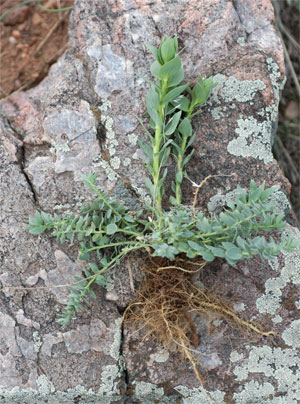
Figure 1. A second year Dalmatian toadflax plant; note prostrate shoots that survived the winter and new shoots that emerged from roots. |
Yellow toadflax (Linaria vulgaris) and the Dalmatian toadflaxes (Linaria dalmatica and Linaria genistifolia) are invasive, perennial weeds that are noxious in Colorado and many other western states. Toadflax invasion is favored by disturbance and they invade degraded areas such as roadsides, abandoned lots and fields, gravel pits, clearings, and overgrazed rangeland. In Colorado, these weed species are found at elevations from 5,000 feet to over 10,000 feet. Yellow toadflax in particular has spread into high mountain valleys and parks. Yellow toadflax infests 40,800 acres in Colorado and Dalmatian toadflax infests 34,200 acres. Infestations of both species are expanding.
Origin and History
The toadflaxes have a storied past and a long relationship with humans. Dalmatian toadflax is native to the Mediterranean region. Broad-leaved Dalmatian toadflax (L. dalmatica) has been cultivated as an ornamental for at least 400 years. It was introduced into the western U.S. as an ornamental in 1874. The majority of Dalmatian toadflax infestations in the west are broad-leaved Dalmatian toadflax; however in its native Eurasian habitat, narrow-leaved Dalmatian toadflax (L. genistifolia) is more widespread, indicating its potential to also invade and become widely dispersed in the U.S. Narrow-leaved Dalmatian toadflax currently infests several areas in western Oregon, northwestern Washington, British Columbia, and possibly in Colorado.
Yellow toadflax is native to south-central Eurasia where it was used for fabric dyes and for medicinal purposes. It was imported into North America in the late 1600s as an ornamental and for folk remedies. It was widely distributed in North America by the mid 20th century. Unfortunately in states where yellow toadflax is not noxious, it still is sold by some nurseries as “butter and eggs” or as “wild snapdragons.”
Biology
Germination and Emergence
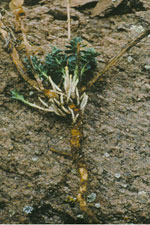
Figure 2. Mature Dalmatian toadflax shoot emergence in early spring; note well-developed deep taproot and lateral roots that were broken off during excavation. |
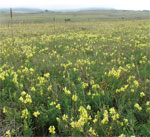
Figure 3. Yellow toadflax usually is 1 to 3 feet tall and often dominates Colorado rangeland. |
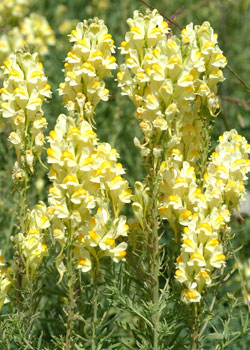
Figure 4. Mature yellow toadflax. |
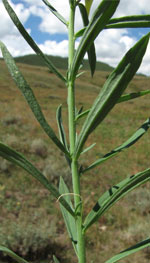
Figure 5. Yellow toadflax shoots and leaves; note narrow, linear leaf shape. |
Seeds of yellow toadflax germinate and emerge in early to mid-May while Dalmatian toadflax seeds may germinate and emerge earlier especially on south or southeast facing slopes. In Washington, Dalmatian toadflax seedlings on south facing slopes usually emerge in early to mid-March. First year Dalmatian toadflax plants often produce prostrate shoots in fall that survive into the following spring (Figure 1). Mature Dalmatian toadflax may produce prostrate shoots, but to a lesser extent, and these typically die before winter and shoots emerge the following spring from roots (Figure 2). Yellow and Dalmatian toadflax shoots that grow from roots emerge as early as mid-March along the Front Range in Colorado, but vegetative shoot emergence may not begin until mid- to late June at 9,000 feet to 10,000 feet. In Canada, vegetative shoots begin to emerge when soil temperatures range from 42F to 50F.
Yellow toadflax shoots are usually 1 to 3 feet tall (Figures 3 and 4) and leaves are narrow, linear, somewhat pointed at both ends, and 1 to 2 inches or more in length (Figure 5). Dalmatian toadflax shoots typically are 2 to 3 feet tall (Figure 6) and leaves are waxy, broad, spade-shaped and bases tend to wrap around shoots (Figure 7). However, Dalmatian toadflax leaves also can be much narrower and lance shaped. Similar to yellow toadflax, Dalmatian toadflax can dominate plant communities after it invades (Figure 8).
Root growth
Seedling root development is slow and represents a life stage vulnerable to control attempts and plant competition. Disturbance promotes toadflax invasion and may be necessary for establishment to occur. However once established, toadflaxes readily spread into adjacent non-disturbed areas. Much of this spread is by vegetative means, reflecting a vigorously-growing root system. Dalmatian toadflax roots may grow 20 inches deep or more nine weeks after seedlings have emerged and have vegetative buds that give rise to new shoots. Patch expansion can be dramatic. In Colorado, Dalmatian toadflax shoot density increased over 1,200 percent in six years at one location and 190 percent over three years at another. Yellow toadflax seedlings produce vegetative shoots from root buds two to three weeks after germination. Mature toadflax have well-developed and extensive root systems. Dalmatian toadflax roots may penetrate the soil 4 feet to 10 feet and lateral roots may extend 10 feet from the parent plant; while yellow toadflax roots grow 3 feet deep or more with lateral roots that may extend several yards.
Flowering
Dalmatian toadflax typically flowers begining in late May or June in Colorado and may continue. until fall, particularly if moisture is not limiting. Yellow toadflax begins to flower when shoots are from 16 to 24 inches tall, mid- to late May along the Front Range in Colorado, although at higher elevations (9,000 feet or more), flowering may not begin until late July. Yellow toadflax may not flower until fall under drought conditions. Yellow toadflax shoot phenology in any given patch may range from vegetative to flowering to seed set, depending on the time of season and environmental conditions (particularly moisture). This contributes to management difficulties.
Management
All toadflax species are difficult to control and management plans should integrate as many strategies as possible to increase potential for success. Assess the condition and composition of the existing plant community in an infested area, then determine the approximate composition of the desired plant community needed to achieve land management goals and objectives. Create a management plan that combines various control strategies to foster development of the desired plant community.
Chemical and Cultural Management of Dalmatian Toadflax
Dalmatian toadflax may be controlled with Tordon 22K at 2 pt/A sprayed at flowering or in fall. In Colorado, rates of 2, 4, and 8 pt/A of Tordon were compared and control longevity was greatest from the 2 pt rate, apparently because competition from crested wheatgrass was maintained. Researchers in Wyoming treated Dalmatian toadflax in early September, 1994, with Tordon at 2 pt/A, then seeded the following year in April or August with ‘Hycrest’ crested wheatgrass, ‘Luna’ pubescent wheatgrass, ‘Critana’ thickspike wheatgrass, ‘Bozoisky’ Russian wildrye, or ‘Sodar’ streambank wheatgrass. The combination of spraying and seeding competitive grasses controlled Dalmatian toadflax better than spraying alone. Three years after treatments were started, control of Dalmatian toadflax ranged from 61 percent to 86 percent where grasses were seeded in April and from 76 percent to 95 percent from the August seeding, compared to no control from spraying alone.
Telar also controls Dalmatian toadflax when applied in fall but relatively high rates (2 oz product/A) are required. Other research in Colorado shows that addition of a silicone/methylated seed oil surfactant at 1 percent (equivalent to 1 gallon per 100 gallons of spray solution) improves control from Telar.
| Table 1: Herbicides used to control Dalmation toadflax. | |||
| Herbicide | Rate (Product/A)
|
Application Timing | Comments |
| Tordon 22K | 2 pt. | Flowering or fall | Best control when applied at full bloom or fall. |
| Telar | 2 oz. | Fall | Improved control achieved with 1 % v/v silicone/methylated seed oil surfactant; NIS at 0.25% v/v can be used if collateral injury to native forbs and shrubs at risk but control will decrease. |
| Plateau | 12 oz. | Fall | Apply when 25% of plant is necrotic, usually after a hard frost. Use a methylated seed oil at 1 qt/A. Cool-season grass injury often occurs from high rates of Plateau applied in fall. |
Chemical Control of Yellow Toadflax
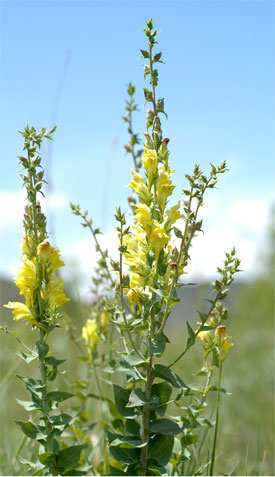
Figure 6. Mature Dalmatian toadflax. |
Yellow toadflax appears to be more difficult to manage than Dalmatian toadflax. In Colorado, control from Tordon 22K applied at flowering has been most consistent and typically, 4 pt/A is recommended. Yellow toadflax usually recovers from a single application. For example, Tordon applied at 4 or 8 pt/A controlled 13 percent and 69 percent of yellow toadflax three years after treatments were applied. Other research conducted in Colorado suggests that yellow toadflax control may be improved if Tordon is applied over three consecutive years, but control varied with location. In one experiment conducted at high elevation (Camp Hale; elevation approximately 10,000 feet), 4 pt/A of Tordon applied at flowering for three consecutive years decreased shoot density to zero. However, the same treatment applied for three years at two other locations (White River drainage, elevation approximately 8,500 feet) controlled 69 percent and 35 percent of yellow toadflax.
Telar also may be used to control yellow toadflax. In an experiment conducted in Middle Park near Parshall, Telar at 1.25 oz/A applied during flowering or in fall controlled 84 percent of yellow toadflax one year later. Telar, however, should be applied at 1.5 oz/A and a non-ionic surfactant (NIS) should be included at 0.25 percent v/v (equivalent to 1 quart per 100 gallons of spray solution). Control of yellow toadflax from Telar can be improved if a methylated seed oil at 1 percent v/v is used instead of a NIS, but injury to native forbs and shrubs may increase.
| Table 2: Chemical control of Yellow Toadflax. | |||
| Herbicide | Rate (Product/A) | Application Timing | Comments |
| Tordon 22K | 2 to 4 pt. | Late flowering to seed capsule/seed set in fall | Control best at seed capsule growth stage. Use high rate for old, dense stands. Treatment may be required for more than one year. |
| Tordon 22K + Overdrive | 2 pt + 8 oz | Late flowering to seed capsule/seed set in fall | Control best at seed capsule growth stage. Treatment may be required more than one year. |
| Telar | 1.5 to 2 oz | Late flowering to seed capsule/seed set in fall | Control best at seed capsule growth stage. Add crop oil concentrate or methylated seed oil. |
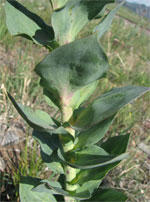
Figure 7. Dalmatian toadflax leaves usually are waxy, spade-shaped, and wrap around shoots. |
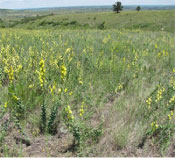
Figure 8. Dalmatian toadflax often dominates rangeland after invasion. |
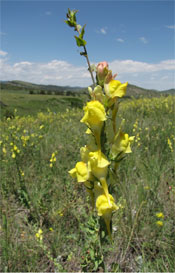
Figure 9. Dalmatian toadflax flowers. |
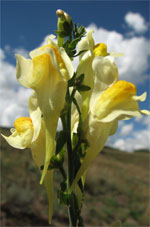
Figure 10. Yellow toadflax flowers. |
Recent CSU research showed that yellow toadflax control was improved when Tordon was mixed with Overdrive. Treatments were applied on August 29, 2007 when yellow toadflax was in the flowering growth stage (not all shoots were flowering) and vegetative root buds 0.5 to 0.75 inches long were present on about 70 percent of crowns examined. Tordon applied alone at 2 or 4 pt/A controlled 53 percent and 70 percent of yellow toadflax, respectively, about one year after treatments were applied; however, when these rates were mixed with Overdrive at 6 oz product/A control improved to 97 percent and 94 percent, respectively. This experiment is being repeated to determine if improved control is consistent.
Other recent research showed that best control was achieved when herbicides were applied when at least 75% of shoots had flowered and were entering the seed capsule growth stage in fall. This yellow toadflax stand condition likely can be most easily observed when less than 25% of shoots at the time of application remain in the vegetative growth stage – all other shoots would be in the late-flower to seed capsule growth stage. CSU research also shows that adventitious root bud development increases rapidly after shoots flower suggesting that these growing tissues may act as a sink for herbicide translocation and this may provide a mechanism to explain the field observations immediately above.
Escort, 2,4-D amine, Banvel, and Paramount controlled from 5 percent to 24 percent of yellow toadflax one year after single treatments were applied at flowering. Plateau showed some potential to control yellow toadflax in another Colorado experiment where 8 oz/A applied once in fall controlled 59 percent of yellow toadflax one year later. While this level of control is unsatisfactory, sequential treatments may increase control but experiments must be conducted to test this hypothesis.
Mechanical and Chemical Control of Yellow Toadflax
Mowing combined with spraying Tordon did not improve control in an experiment conducted near Hesperus, Colorado. Yellow toadflax was mowed three times per year then treated with Tordon at 4 pt/A in fall for two consecutive years and compared to Tordon applied at 4 pt/A at flowering also for two consecutive years. Yellow toadflax control was the same (85 percent) whether Tordon treatments were combined with mowing or not.
Biological Control of Toadflaxes
Several classical biocontrol agents are available to use against toadflaxes. However, the success of these agents remains largely unknown. A defoliating moth (Calophasia lunula), an ovary-feeding beetle (Brachypterolus pulicarius), and two-seed capsule-feeding weevils (Gymnaetron antirrhini and G.netum) have been released in the U.S. and Canada to control all toadflax species. Particularly the flowering and seed feeding insects should help decrease seed production.
A stem-boring weevil (Mecinus janthinus) and a root-boring moth (Eteobalea intermediella) also were released in Canada and the U.S. to control all species of toadflax. These species may help to control shoots and seed production as well as decrease root vigor, but data are unavailable to document their effects. Several of these classical biocontrol agents are available from the Colorado Department of Agriculture Insectary in Palisade. Very few published studies are available to determine whether grazing by livestock will effect any control of Dalmatian or yellow toadflax.
*K.G. Beck, Colorado State University Extension weed science specialist and professor of weed science, bioagricultural sciences and pest managment. 5/01. Reviewed 10/09.
Go to top of this page.





